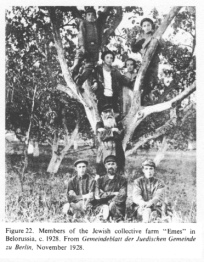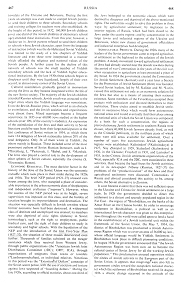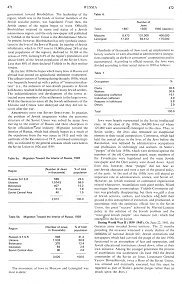[Discrimination
of the middle class Jews: NEP, lishentsy, Five-Year Plan
- help from organizations - dollars campaign against the
Jews - forced agricultural settlement, migration or town
settlement]
<ECONOMIC RESHUFFLE.
The most decisive factor in the history of the Jews
of the Soviet Union was the economic reshuffle which took
place in their midst during the 1920s and 1930s.
NEP:
The brief NEP period (1921-27) aroused vain hopes among
the Jews, who occupied a place of considerable importance
in the urban economic class of shopkeepers and independent
craftsmen ("nepmen"). However, when the success of the NEP
period was at its height, severe supervision was imposed
on this class, and the burden of taxation brought its
impoverishment and destruction. The situation was
especially difficult in Jewish townlets whose former
economic basis had been destroyed. A widespread class of
destitute and unemployed was created; its members were
also deprived of civic rights (lishentsy in Soviet terminology), such
as the right to employment, public medical care, and the
right of their children to study in secondary and higher
schools.
[[Further detail see: Yehuda Bauer: Joint
]].
Five-Year
Plan: With the liquidation of the NEP and the
introduction of the first Five-Year Plan (1927-32), the
situation of these masses deteriorated even further.
Thousands of families subsisted on the meager assistance
which they received from Western Jewry, through public
organizations (the *American Jewish Joint Distribution
Committee (JDC); ORT; ICA), through organizations of
emigrants from towns or townlets (*Landsmannschaften), or
individual relatives.
Notorious in this period was the "Extortion of Dollars"
campaign of the Soviet secret police, with the use of
coercion [[violence]] and torture against Jews suspected
of "hoarding dollars".
During
the late 1920s, according to official statistics, about
one-third of (col. 467)
the Jews belonged to the economic classes which were
destined to disappear and deprived of the above-mentioned
rights. The authorities sought to solve this problem in
three ways:
-- by agricultural settlement;
-- by migration to the interior regions of Russia, which
had been closed to the Jews under czarist regime;
-- and by concentration in the large towns and industrial
regions of the Ukraine and Belorussia [[Belarus]], where
new classes of government officialdom and industrial
enterprises had developed.
[[Further detail see: Yehuda Bauer: Joint
]].
<In
Soviet Russia After 1917, in the [[criminal Gulag]]
Soviet Union there continued, up to 1928 approximately,
a long period of the break-up of the stetl economy and
the penalization of many Jews as "bourgeois elemtnes",
in the legal, economic, and social aspects of existence.
This policy was followed, even if they had been petty
shopkeepers of small scale artisans under the czarist
regime, without taking into account the restrictions
that had forced them into their petty bourgeois status.
In this case also a "general line of policy" turned out
to be destructive and unfair to Jewish socitey in
particular. During the economic crisis the Soviet
government was favorable to Jewish autonomy (there were
many preponderantly Jewish municipalities and even
several such regional administratibve units even after
the end of the 1920s). The setting in of
industrialization around 1928 gave new opportunities to
Jews and began to compensate many of them for the former
social havoc.
In the 1920 the [[criminal Gulag]] Soviet state
encouraged a change in Jewish economy and society
through agriculture and settlement in compact groups,
first in the *Crimea
and the south of the *Ukraine
- which had been traditional areas for Jewish
agricultural settlement with governmental encouragement
from the first half of the 19th century - and later in
what was proclaimed to be the autonomous Jewish region
of *Birobidzhan.
The projects proceeded rapidly with the help of Jews
from abroad.>
(Encyclopaedia Judaica (1971): History, vol. 8, col.
741)
[[The agricultural "settlements" on Crimea were part of
the racist Zionist Israel program. The Jewish farmers
should emigrate to Palestine forming the base of the new
"Jewish State". They settlements were the preparation to
set up a racist Zionist "Jewish State" in Palestine...]]
AGRICULTURAL
PROJECTS. [Jews should be converted into peasants -
Komzet - Jewish settlements in Ukraine - Birobidzhan
project]
During the 1920s many of the leaders of the Soviet
government came to regard agricultural settlement
[[village]] as the highroad to the solution of the Jewish
problem. A steady movement toward agricultural settlement
of Jews had already started near the Jewish townlets
during the period of war Communism in the years of the
civil war, when occupation in agriculture at least
promised a piece of dry bread.
Komzet
and Ukraine [and Crimea]: In 1924 the government
created the Commission for Jewish Settlement (Komzet) and
a year later a Society for the Promotion of Jewish
Settlement (Ozet) was founded. Several Soviet leaders, led
by M. Kalinin and M. *Larin, viewed this settlement
[[arrangement]] not only as an economic solution for the
Jews but also as a means of assuring their national
[[religious]] existence. Some members of the Yevsektsiya
accepted these projects with enthusiasm and devoted
themselves to their realization. These circles aimed to
establish Jewish settlement in successive blocs which
would form autonomous national areas and would eventually
find their place among the national units of which the
Soviet Union was composed.
As a basis for such a concentration, the regions of
prerevolutionary Jewish settlement in southern Russia were
chosen, where 40,000 Jewish farmers already lived, as well
as the Crimean peninsula, in the northern parts of which
there were still areas available for settlement. Over a
number of years five autonomous Jewish agricultural
regions were established:
--
Kalinindorf (*Kalininskoye) in 1927,
-- Nay Zlatopol in 1929,
-- Stalindorf (Stalinskoye) in 1930, in the Ukraine;
-- Fraydorf in 1931,
-- and Larindorf in 1935, in the Crimea.
![Encyclopaedia Judaica (1971): Russia,
vol. 14, col. 469, [[racist Zionist]]
members of He-Halutz [[racist Zionist
"pioneers"]] on Tel Hai farm in
Crimea in 1925 [[in their preparation for
emigration to Palestine]] Encyclopaedia Judaica (1971): Russia,
vol. 14, col. 469, [[racist Zionist]]
members of He-Halutz [[racist Zionist
"pioneers"]] on Tel Hai farm in
Crimea in 1925 [[in their preparation for
emigration to Palestine]]](EncJud_juden-in-SU-d/EncJud_Russia-band14-kolonne469-He-Halutz-auf-Tel-Hai-hof-Krim-1925-55pr.jpg)
Encyclopaedia Judaica (1971): Russia, vol. 14,
col. 469, [[racist Zionist]] members of
He-Halutz [[racist Zionist "pioneers"]]
on Tel Hai farm in Crimea in 1925 [[in their
preparation for emigration to Palestine]] |
Jewish settlement organizations of the
West, especially ICA and the JDC, were associated in these
activities. Ozet became the legal focus for Jewish
activities, and in its newspaper Tribuna (Russian, 1927-37) the problems
of the "productivization" of the Jews and their
agricultural settlement were discussed. Communists of
Russia and abroad considered this activity to be, among
others, the Soviet alternative to [[racist]] Zionism.
It soon became evident that there was not sufficient space
in the Ukraine and Crimea for Jewish settlement on a large
scale.
[[The existing Jewish agricultural settlements cut land
from other settlements and this provoked a bad mood
towards the Jews. See: *Crimea]].
<In
1926, 150,400 Jews gained their livelihood from
agriculture, approximately 6% of the total. By 1928 they
numbered 220,000 (8.5%). A peak was reached in 1930 with
10.1% of Russian Jews in agriculture. Subsequently a
steady decline both in absolute (col. 741)
numbers, and even more proportionally, set in [[by
industrialization]].> (col. 742)
(Encyclopaedia Judaica (1971): History, vol. 8, col.
742)
[[The high agricultural percentage is not normal for
Jews. The Jewish farmers were part of the racist Zionist
plan to emigrate to Palestine to be the base of a racist
"Jewish State"]].
Birobidzhan:
In 1928 the government decided to direct this settlement
to a distant and sparsely populated region in the Far East
- the region of *Birobidzhan, on the banks of the Amur
River on the Chinese border. In order to encourage
settlement in Birobidzhan, a political as well as an
international Jewish character was given to this
enterprise. Jews throughout the world were called upon to
lend a hand in the establishment of a Jewish territorial
unit within the framework of the Soviet Union. On May 7,
1934, the district of Birobidzhan was proclaimed a Jewish
Autonomous Region which was to cover an area of 36,000 sq
km, whose official language would be Yiddish. Settlement
in Birobidzhan took place in difficult pioneering
conditions.
|
Encyclopaedia Judaica (1971):
Russia, vol. 14, col. 470, title page of the
Komzet report about farming settling
possibilities in Birobidzhan published in 1930 |
[[There were hopes that also Polish Jews would go to
Birobidzhan and the "Jewish problem" in Poland would be
solved by this. See: Yehuda Bauer: Joint
]].
In August 1936 the government announced that "the Jewish
Autonomous Region was from now on to become the cultural
center of Soviet Jewry for all the working Jewish
population". This proclamation aroused opposition within
the circles of Jewish activists in the European part of
the Soviet Union. It appears that misgivings were also
felt in government circles toward the outspoken national
character which the settlement of Birobidzhan received.
In August 1936 a drastic change occurred in the
attitude of the (col. 468)
government toward Birobidzhan. The leadership of the
region, which was in the hands of former members of the
Jewish socialist parties, was liquidated. From then, the
Jewish aspect of the region began to wane. Officially
Birobidzhan retained its name and status of a Jewish
autonomous region, and the only newspaper still published
in Yiddish in the Soviet Union is the Birobidzhaner Shtern.
At present, however, Birobidzhan has only symbolic
importance in the lives of the Jews of Russia. Its number
of Jewish inhabitants, which in 1937 rose to 18,000 (about
24% of the total population of the region), declined to
14,169 in the census of 1959, forming 8.8% of the region's
population and about 0.66% of the Jewish population of the
Soviet Union. Less than 40% of them declared Yiddish to be
their mother tongue.
[[Further details see also: *Birobidzhan]]
[[There was a general liquidation wave (purges) of Stalin
in 1936-1937]].
[Late
1930s: collectivization destroying big parts of the
agricultural settlements - end in 1941]
<During
the collectivization of Soviet agriculture most Jewish
settlement were practically de-Judaized by an
"internationalization" process, i.e., the introduction
of non-Jewish peasants. The Jewish settlements were
finally obliterated during the Nazi occupation of World
War II.>
(Encyclopaedia Judaica (1971): History, vol. 8, col.
742)
By the late 1930s the hopes which many Jews in Russia and
abroad had pinned on agricultural settlement evaporated.
The collectivization of farming during the early 1930s,
which was frequently bound up with a policy of
"internatinalization" (i.e., the inclusion of non-Jewish
peasants in Jewish kolkhozes), resulted in the departure
of many Jewish settlers. The industrialization and
development of the towns attracted many members of the
settlements to the large towns. With the German invasion
all the Jewish settlements of the Ukraine and Crimea were
destroyed and they did not recover after the war [[because
the agricultural settlements also were considered as
training for Palestine]].
[[The collectivization ended in a catastrophe and famine,
see: Yehuda Bauer: Joint
]].
ABSORPTION INTO THE SOVIET STRUCTURE.
In practice, the problem of Jewish integration within the
economic structure of the Soviet Union was solved by many
Jews moving to the interior of Russia and their absorption
in Soviet officialdom [[bureaucracy]] and industry.
Migration toward the interior of Russia, which had already
begun as a result of the expulsions from the war zones in
1915 and with the outbreak of the Revolution of 1917,
continued uninterruptedly, as indicated by the general
censuses which were held in the Soviet Union in 1926 and
1939.
[[Factors are:
-- opening of central Russia for the Jews
-- Birobidzhan
-- collectivization and Jews giving up the agricultural
settlements
-- better working conditions in the Russian industries
-- school standards in the towns]].
Table 5a / 5b: Jewish migration toward
the Interior of Russia 1926-1939
|
Regionxxxxxxxxxxxxxxxxxxxx
|
Number of Jews 1926
|
% of total population 1926
|
Number of Jews 1939
|
% of total population 1939
|
Russian
S.F.S.R.
|
599,000xxxxx
|
22.4%xxxxxx |
948,000xxxxxx |
31.4%xxxxxxx |
Ukraine
|
1,574,500xxxxx |
59.0%xxxxxx |
1,533,000xxxxxx |
50.8%xxxxxxx |
Belorussia
|
407,000xxxxx |
15.2%xxxxxx |
375,000xxxxxx |
12.4%xxxxxxx |
Caucasus
|
51,500xxxxx |
1.9%xxxxxx |
84,000xxxxxx |
2.8%xxxxxxx |
Soviet
Central Asia
|
40,000xxxxx |
1.5%xxxxxx |
80,000xxxxxx |
2.6%xxxxxxx |
from: Russia; In:
Encyclopaedia Judaica, vol. 14, col. 471
|
Table 6: [Jewish migration to Moscow
and Leningrad [[St. Petersburg]] 1897-1940
approx.]
|
Town
|
Number
of Jews
|
|
1897
|
1926
|
1940 (approx.)
|
| Moscow |
8,473xxxx
|
131,000xxxxxxx
|
400,000xxxxxxx
|
Leningrad
[[St. Petersburg]]xxxxxxxxx
|
17,251xxxx |
84,412xxxxxxx |
175,000xxxxxxx |
from: Russia; In:
Encyclopaedia Judaica, vol. 14, col. 472
|
Hundreds of thousands of Jews took up employment as
factory workers or were absorbed in administrative
occupations (especially as clerks in consumers'
cooperatives and in accountancy). According to official
sources, the Jews were divided according to their social
status in 1939 as follows:
Table 7: [Jewish professions in
Russia in 1939]
|
Occupation
|
%
|
Clerks
|
40.6%xxxxxxxxxxxxxxx
|
Workers
|
30.6%xxxxxxxxxxxxxxx |
Cooperative
craftsmenxxxxxxxxxxxxxxxxxxxxx
|
16.1%xxxxxxxxxxxxxxx |
Individual
craftsmen
|
4.0%xxxxxxxxxxxxxxx |
Peasants
in kolkhozes
|
5.8%xxxxxxxxxxxxxxx |
Others
|
2.9%xxxxxxxxxxxxxxx |
Total
|
100.0%xxxxxxxxxxxxxxx |
| from: Russia; In:
Encyclopaedia Judaica, vol. 14, col. 472 |
[More
assimilation factors]
Jews were largely represented in the Soviet intellectual
class. At the close of the 1930s, 364,000 Jews (of whom
125,000 were accountants) belonged to this class. Thus, in
Soviet society, the Jews also remained an exceptional
element in their social composition. Commerce, which had
held the central place in the lives of the Jews before the
Revolution, was replaced by administrative occupations and
professions in technology and sciences.
In Stalin's "purges" of the late 1930s, which were
directed against the members of the old Communist guard,
many members of the Yevsektsiya were liquidated and the
main Jewish newspaper and the Ozet society were closed
down. Apart from this, however, these "purges" did not
bear an anti-Jewish character and were a part of the
general policy of the party.
At the end of the 1930s Jews still played an important
role in administration, science, and Soviet art. However,
no Jewish national or communal organization existed
whatsoever. Assimilation took giant strides. Mixed
marriages became commonplace. Yiddish-Communist culture
was gradually disappearing, but there was still a class of
Jewish activists, authors, and teachers who held their
ground in this atmosphere of extinction, and proclaimed,
in accordance with the optimistic official line in the
Soviet Union, the great "success" achieved by
Marxist-Leninist policy in the solution of the Jewish
problem and the "renovated Jewish people" (dos banayte folk)
which had emerged in the Soviet Union.> (col. 472)
[Racist
Zionists in the Soviet Union preparing emigration for
Palestine for a racist "Jewish State"]

Encyclopaedia Judaica (1971): Russia, vol. 14,
col. 470, farmers of Emes in Belarus in 1928
approx. |
![Encyclopaedia Judaica (1971): Russia,
vol. 14, col. 469, [[racist]] Zionist
political captives in Bobruisk in 1926 Encyclopaedia Judaica (1971): Russia,
vol. 14, col. 469, [[racist]] Zionist
political captives in Bobruisk in 1926](EncJud_juden-in-SU-d/EncJud_Russia-band14-kolonne469-zion-gef-Bobruisk-1926-55pr.jpg)
Encyclopaedia Judaica (1971): Russia, vol. 14,
col. 469, [[racist]] Zionist political captives
in Bobruisk in 1926 |
|
Sources
|

Encyclopaedia Judaica (1971): Russia, vol. 14,
col. 467-468 |

Encyclopaedia Judaica (1971): Russia, vol. 14,
col. 471-472 |




![Encyclopaedia Judaica (1971): Russia,
vol. 14, col. 469, [[racist Zionist]]
members of He-Halutz [[racist Zionist
"pioneers"]] on Tel Hai farm in
Crimea in 1925 [[in their preparation for
emigration to Palestine]] Encyclopaedia Judaica (1971): Russia,
vol. 14, col. 469, [[racist Zionist]]
members of He-Halutz [[racist Zionist
"pioneers"]] on Tel Hai farm in
Crimea in 1925 [[in their preparation for
emigration to Palestine]]](EncJud_juden-in-SU-d/EncJud_Russia-band14-kolonne469-He-Halutz-auf-Tel-Hai-hof-Krim-1925-55pr.jpg)


![Encyclopaedia Judaica (1971): Russia,
vol. 14, col. 469, [[racist]] Zionist
political captives in Bobruisk in 1926 Encyclopaedia Judaica (1971): Russia,
vol. 14, col. 469, [[racist]] Zionist
political captives in Bobruisk in 1926](EncJud_juden-in-SU-d/EncJud_Russia-band14-kolonne469-zion-gef-Bobruisk-1926-55pr.jpg)

